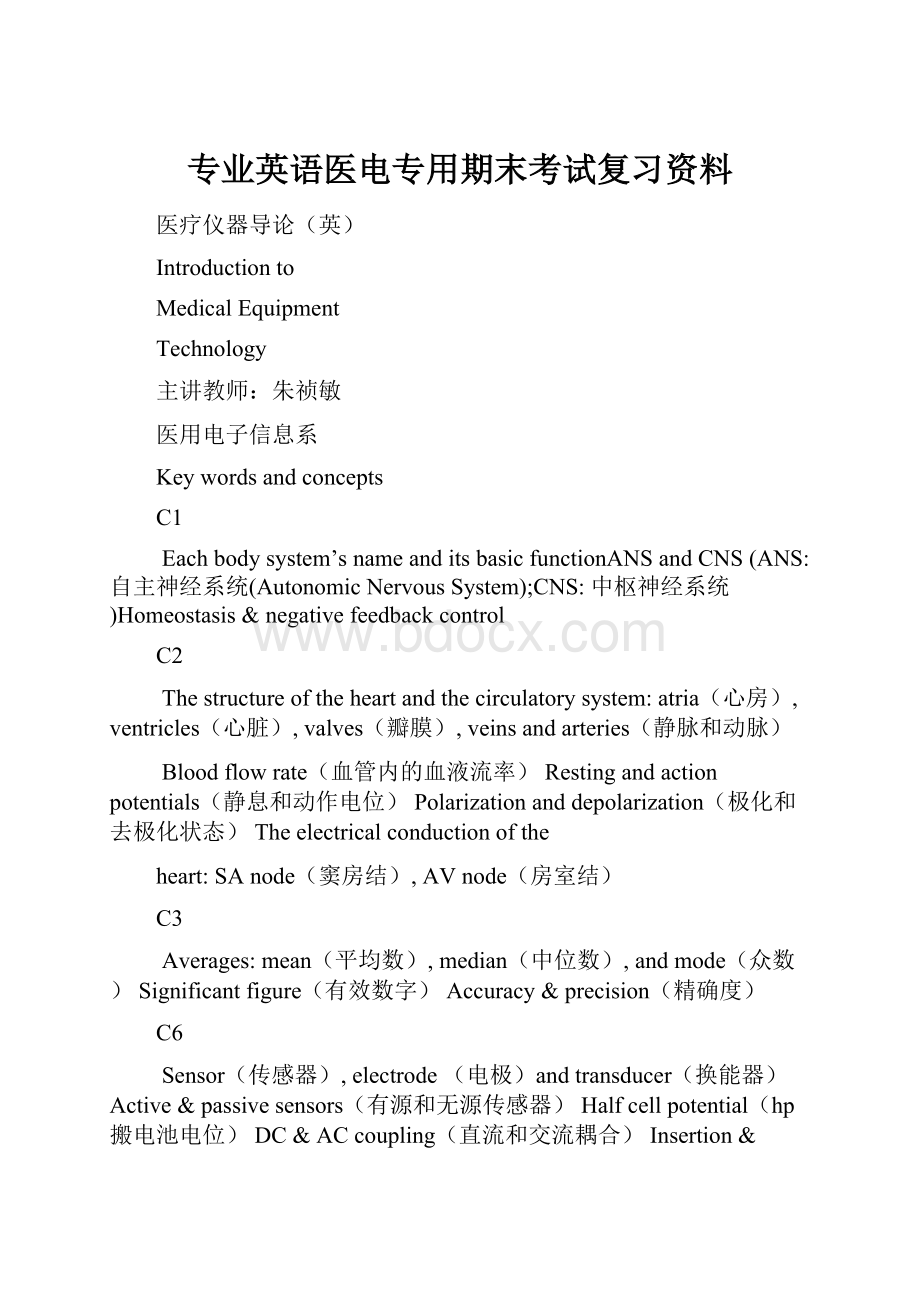专业英语医电专用期末考试复习资料.docx
《专业英语医电专用期末考试复习资料.docx》由会员分享,可在线阅读,更多相关《专业英语医电专用期末考试复习资料.docx(39页珍藏版)》请在冰豆网上搜索。

专业英语医电专用期末考试复习资料
医疗仪器导论(英)
Introductionto
MedicalEquipment
Technology
主讲教师:
朱祯敏
医用电子信息系
Keywordsandconcepts
C1
Eachbodysystem’snameanditsbasicfunctionANSandCNS(ANS:
自主神经系统(AutonomicNervousSystem);CNS:
中枢神经系统)Homeostasis&negativefeedbackcontrol
C2
Thestructureoftheheartandthecirculatorysystem:
atria(心房),ventricles(心脏),valves(瓣膜),veinsandarteries(静脉和动脉)
Bloodflowrate(血管内的血液流率)Restingandactionpotentials(静息和动作电位)Polarizationanddepolarization(极化和去极化状态)Theelectricalconductionofthe
heart:
SAnode(窦房结),AVnode(房室结)
C3
Averages:
mean(平均数),median(中位数),andmode(众数)Significantfigure(有效数字)Accuracy&precision(精确度)
C6
Sensor(传感器),electrode(电极)andtransducer(换能器)Active&passivesensors(有源和无源传感器)Halfcellpotential(hp搬电池电位)DC&ACcoupling(直流和交流耦合)Insertion&applicationerrors(插入误差,应用误差)Surfaceindwelling(宏电极)micro-(微电极),needleelectrodes(针电极)
C7
Importantkindsofop-amps(运算放大器)Inverting&noninverting(反相与同相运算放大器)Input&output(输入输出)
C8
DiagnosticandMonitoring(诊断和监测)ECGLead(心电图导联),limb&chestlead(肢体和胸),unipolar&bipolarlead(单极和双极导联),augmentedlead(加压导联)
Otherimportantwordsandphrases
Circuit(电路系统)Voltage(电压),current(电流),resistance(电阻)Ohm’slaw(欧姆定律),Kirchhoff'slaw(基尔霍夫定律)Directandalternating(直流和交流)Resistance(电阻),capacitance(电容)andInductance(电感)
Resistor(电阻器),capacitor(电容器)andinductor(电感器)
Otherimportantwordsandphrases
Analoganddigitelectronics(模拟和数字电子)Diode&transistor(二极管和三极管)Continuousrangeofvoltages(持续的电压范围)Discretevoltagelevels(离散电压等级)Waveform(波形)
ECG(心电图),EEG(脑电图),EMG(肌电图),EOG(动眼电波图),EGG(胃电图)
WhatarethemaincontentsofourMETcourse?
TheHeartandCirculatorySystem
IntroductiontoBiomedicalInstrumentationandMeasurement
Electrodes,Sensors,andTransducers
BioelectricAmplifiers
1TheHumanBody:
AnOverview
课程介绍
17MedicalUltrasonography
8Electrocardiography
14IntensiveandCoronaryCareUnits
9PhysiologicalPressureandOther
CardiovascularMeasurements
Vocabularytransducer
词根trans:
转换transfertranslatetransformerelectrocardiography
词根cardio:
心脏的cardiologycardiologist
Vocabularyultrasonography
词根ultra:
beyond,超过
ultraviolet(UV)ultraman
C1.TheHumanBody:
AnOverview
C6.Electrodes,Sensors,andTransducers
C8.Electrocardiography
C9.PhysiologicalPressureandOther
CardiovascularMeasurements
HowcanyoustudyMETwell?
Reading
Exercise
Translation
Vocabulary
ABiomedicalEquipmentTechnician(BMET)isavitalcomponentofthehealthcaredeliverysystem.Employedbyhospitals,clinics,andthemilitary;BMETsarehighlyskilledtechniciansresponsibleforensuringmedicalequipmentisdeemedserviceable,safe,andproperlyconfiguredtomeetthemissionofahospitalorganization.Thesemenandwomenareresponsibleforinstalling,inspecting,repairing,calibration,preventivemaintenance,education,andmodificationofbiomedicalequipmentand
supportsystems.
Examplesofdifferentareasofbiomedicalequipmenttechnologyare:
Radiographicandflouroscopicx-ray,Diagnosticultrasound,LASERs,Mammography,Telemedicine,Filmimageprocessing,NuclearMedicine,Gammacameras,Positronemissiontomography(PET),Medicalimaging,ComputedTomography(CT),Electronmicroscope,Picturearchivingandcommunicationsystems(PACS),MagneticResonanceImaginginstrument(MRIscanner),Physiologicalmonitoring,Sterilization,Dental,Optometry,Surgical,Anesthesia,Laboratory,Dialysis,RespiratoryServices(ventilators),Computers,andInformationTechnology.
Radiographicandflouroscopicx-ray(X线照相术)
Mammography(乳房影像)
iagnosticultrasound(诊断用超声)
PhotocourtesyPhilipsResearch
3Dultrasoundimages
LASER(激光)
LaserBurnDebridementProcedure
NuclearMedicine(核医学)
Nuclearmedicineimagingtechniquesgivedoctorsanotherwaytolookinside
thehumanbody.Thetechniquescombinetheuseofcomputers,detectors,
andradioactivesubstances.Thesetechniquesinclude:
•Positronemissiontomography(PET)
•Singlephotonemissioncomputedtomography(SPECT)
•Cardiovascularimaging
•Bonescanning
MethodsofRadioactiveDecay(放射性衰变的方式)
Gammacamera(伽马照相机)
γ-肺γ-胸腔γ-心室
Gammacamera(伽马照相机)
准直器探测晶体光电倍增管铅板
Gammacamera(伽马照相机)
Positronemissiontomography(PET)正电子发射体层摄影
Apositron-emissiontomography(PET)imageisa
'photograph'ofhigh-energyγ-raysemittedfroma
positron-emittingradioisotope.
PET-脑
PET-充盈心肌
PET-缺血心肌
ComputedTomography(CT)X射线计算机断层摄影
ACT(computedtomography)scanisamuchmoresensitiveimagingtechniquethanx-ray,allowinghighdefinitionofnotonlythebonystructuresbutalsothesofttissues.Clearimagesoforgansandstructures,suchasthebrain,muscles,joints,veinsandarteries,aswellasoftumorsandhemorrhages(n.出血),maybeobtainedwithorwithouttheinjectionofcontrastingdye.
CT-肾
ComputedTomography(CT)X射线计算机断层摄影
ImageanobjectfrommanydifferentdirectionsUseacomputertocalculatetheinteriorstructureofthatobjectfromtheseprojectedimages
MRI-脑
MagneticResonanceImaginginstrument(MRIscanner)核磁共振仪
AnMRI(magneticresonanceimaging)ofthebraincreatesadetailedimageofthe
complexstructuresinthebrain.AnMRIcreatesathree-dimensionalpictureofthe
brain,whichallowsdoctorstomorepreciselylocateproblemssuchastumorsor
aneurysms(n.动脉瘤).
AnIntravenous
X-Ray
pyelogram(IVP,静脉注射肾盂造影)isaconventionalx-raytestusingdyetoexamine.Thisx-rayallowsvisualizationoftheupperandlowerurinarytracttodeterminethepresenceofanyabnormality.
CT
CTscanningisessentiallyadetailedX-rayofthebody.CTshowscross-sectionsofthebodyandallowsyourdoctortoseedetailsoftheanatomythatwouldnotbeseenonregularx-ray.
MRI
MRIismoresensitivethanCTscanning.CTandMRIhavetheaddedbenefitof
detectingenlargedlymphnodesnearthetumors,whichcansuggestthatacancerhasspread(metastasized)tothelymphnodes.
MRI与CT相比较的各自优缺点
MRI的缺点
钙化及骨病灶不能显示;扫描时间一般较长,每日能检查的人数较CT少;上腹部MRI仍存在运动伪影干扰;体内有磁性金属物者不能检查;价格昂贵。
MRI的优点
无放射线损害,迄今也未见有MRI对人体产生损伤的报道;软组织密度分辨率高于CT,而空间分辨率也可与CT相媲美,直径小于2厘米的胰癌也能发现;可直接作任意的切层扫描;成像参数及方法多,所获得诊断信息较CT丰富;一般无需作增强扫描,近年采用的一种特殊的MRI增强剂(Gd-DT-PA)以增强病灶的信号对比,且无潜在危险的碘过敏反应;借助于质子的流动效应,可清晰显示血管,尤其是运用数字减影原理可作MRI血管造影;⑦无骨性伪影,对颅窝病变的诊断比CT优越得多。
MRI与CT相比较的各自优缺点
CT的优点
钙化及骨病灶能显示;
扫描时间一般较短,每日能检查的人数较MRI多;
上腹部不存在运动伪影干扰;
体内有磁性金属物者能检查;
价格便宜。
CT的缺点
软组织密度分辨率低于MRI;
成像参数及方法少,所获得诊断信息较较MRI少;
有骨性伪影,对颅窝病变的诊断比MRI差得多;
有放射线损害。
Borsook
etal.NatureReviewsDrugDiscoveryadvanceonlinepublication;publishedonline07April2006|doi:
10.1038/nrd2027Magneticresonanceimages(MRI)areusedtotakepicturesofandstudythebrain.PET(positronemissiontomography)scansshowbrain
activity,andchemicalsshowhowtransmittersfunction.
Telemedicine(远程医疗)Thedefiningaspectoftelemedicineistheuseofelectronicsignalstotransfernformationfromonesitetoanother.
C1.TheHumanBody:
AnOverview
(人体概述)
Objectives
Listmajorsystemsofthebody.
Describetheprincipalfunctionsofbodysystems.
Describehowthebodycontrolsandregulatesitself.
Statetherelationshipsamongbodysystems.
列出人体的主要组成系统。
描述人体各组成系统的基本功能。
描述人体如何进行自我调控。
阐述人体各组成系统之间的关系。
学习目标
C1.TheHumanBody:
AnOverview
(人体概述)
TextNotes
1.FeedbackControlSystem
Thebodycontainsliterallyhundredsoffeedbackcontrolsystemsthatattempttokeepthebody’sinternalenvironmentconstant.Thisprocessiscalledhomeostasis.
1.反馈控制系统
确切地说,人体含有数百个反馈控制系统用以维持其内环境稳定。
该过程称为体内平衡。
C1.TheHumanBody:
AnOverview
(人体概述)
TextNotes
2.TheCell
Allmammals,includinghumans,aremadeupofbasicbuildingblockscalledcells.Theyareallsimilarintheirbasicconstituents.
2.细胞
包括人类在内的所有哺乳动物都是由基本结构单元(称作细胞)构成的。
不同的细胞的基本组成要素却是相似的。
TextNotes
3.CellMembrane
Thecellissurroundedbyasemipermeablemembrane.Thismembranenotonlycontainsthesubstanceofthecellbutalsoallowsselectivepassageofmaterialsinandoutofthecell.
3.细胞膜
细胞由半透膜包裹。
该膜结构不仅能容纳细胞自身物质,同时还可实现细胞内外的物质选择性透过。
C1.TheHumanBody:
AnOverview
(人体概述)
100%-0%:
Theimbalanceismaintainedbecausethemembraneisimpermeabletothation.Diffusion
50%-50%:
ionsdiffuseacrossthemembranebecauseitispermeable.
Equilibriumisreached.SelectivePermeabilityTwokindsofions:
Themembraneisimpermeabletoboth.Semipermeable:
permeabletoonly
onekindofion,butisimpermeabletotheother.
4.MusculoskeletalSystem
Themusclesandbonesofthebodyprovidelocomotion(i.e.,theabilitytomovearoundandmanipulateoursurroundings).Theskeletalsystemconsistsmostlyofbonesandsomecartilage.Thebonesarejoinedtogethertoformarticulationsandjointsandsoareabletomovewithrespecttoeachother.Ingeneral,musculesareconnectedbetweenbonesacrossajoint,sothatthebonesmovewithrespecttoeachotherwhenthemusclecontracts.
4.肌肉与骨骼系统
肌肉和骨骼可使人体产生运动(即,能够自由移动、改造自然的能力)。
其中骨骼系统主要由骨骼和一些软骨构成,且骨骼连接在一起形成关节以进行协同运动。
而肌肉一般跨过关节附着在骨骼之上,因此肌肉收缩便会产生骨骼协同运动。
5.RespiratorySystem
Therespiratorysystemtakesoxygenintothebodyandgivesoffcarbondioxidewasteproductsfromthecells.Therespiratorysystemincludesthemouth;nose;trachea,orwindpipe;;bronchiandlungs.
5.呼吸系统
呼吸系统从外界摄取氧气并排出细胞产生的二氧化碳废气。
呼吸系统由嘴、鼻腔、气管、支气管和肺构成。
Weneedtogetoxygenintothebloodfromtheair,and
weneedtoremovewastecarbondioxidefromthebloodintotheair.Movinggaseslikethisiscalledgasexchange.Thealveoliareadaptedtomakegasexchangeinlungshappeneasilyandefficiently.
6.GastrointestinalSystem
TheGIsystemtakesinrawmaterialsintheformoffoodandliquidsandpocessesthemsothattheyareabsorbedintothebody.Certaindigestiveorgansareneededtochemicallyandphysicallyprocesstheserawmaterials:
theliver,gallbladder,salivaryglands,pancreas,stomach,